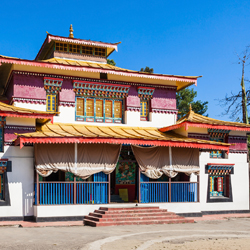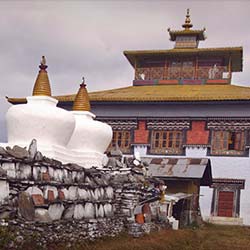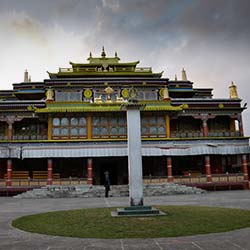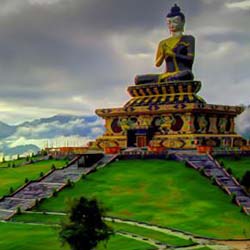
- Home
- Travel Packages
- Top Destination
-
Travel Attraction
By Category
Top Attraction

- Travel Agents
- Car Rentals
- Hotels

About Enchey Monastery The Enchey Monastery, located in Gangtok, Sikkim, is a prominent Buddhist monastery that holds great religious significance for the local community. It is known for its serene surroundings and peaceful ambiance, making it a popular destination for spiritual seekers and tourists alike. Architectural Facts The Enchey Monastery is a beautiful example of traditional Tibetan architecture, with intricate wood carvings and colorful murals adorning its walls. The main shrine houses a statue of Buddha along with other deities, and the prayer hall is adorned with prayer flags fluttering in the wind. History Founded in the 19th century, the Enchey Monastery has a rich history tied to the Nyingma school of Tibetan Buddhism. It is believed to be built on a site blessed by Lama Druptob Karpo, a revered sage who meditated at the location. Location The Enchey Monastery is located just 3 kilometers from Gangtok city center, making it easily accessible for visitors. The monastery is nestled amidst lush greenery and offers stunning views of the surrounding mountains. Visiting Hours The Enchey Monastery is open to visitors from 6 am to 4 pm every day, allowing ample time for exploration and prayer. It is recommended to visit early in the morning to experience the monks' chanting prayers. Gurudwara Services and Events The Enchey Monastery hosts special events and festivals throughout the year, including the annual Cham Dance festival that attracts devotees from far and wide. Additionally, the monastery offers weekend retreats and meditation sessions for those seeking spiritual guidance. Regarding timings, the monastery is open on weekends, providing visitors with the opportunity to participate in religious services and learn more about Tibetan Buddhism. Accessibility and Directions Visitors can reach the Enchey Monastery by car or public transport, with ample parking available near the entrance. The monastery is wheelchair accessible, ensuring that all visitors can explore its sacred grounds comfortably. Visitor’s Information Entry to the Enchey Monastery is free of charge, but donations are welcome to support the upkeep of the monastery. Visitors are advised to dress modestly and remove their shoes before entering the prayer hall as a sign of respect. Guides are available for those who wish to learn more about the monastery's history and significance. Nearby Attractions While visiting the Enchey Monastery, visitors can explore other nearby attractions such as the Namgyal Institute of Tibetology, Tsomgo Lake, and the Rumtek Monastery. These sites offer further insight into Tibetan culture and history, making for a fulfilling and educational journey. Best Time to Visit The best time to visit the Enchey Monastery is during the months of October to December when the weather is pleasant and clear, offering stunning views of the Himalayan mountains. The monastery's annual festivals and events also take place during this time, providing a unique cultural experience for visitors.
Explore More
About Bonn Monastery, Ravangla History The Bonn Monastery in Ravangla, Sikkim, is a sacred place for followers of the Bon religion, which predates Buddhism in Tibet. The monastery was established in 1988 and is one of the main centers of the Yungdrung Bon tradition in India. It serves as a spiritual retreat for practitioners seeking peace and enlightenment. Architecture and Design The Bonn Monastery features traditional Tibetan architecture with vibrant colors, intricate designs, and ornate details. The main prayer hall is adorned with colorful murals, thangka paintings, and religious statues. The architecture reflects the rich cultural heritage of the Bon religion and creates a serene atmosphere for meditation and prayer. Best Time to Visit The best time to visit the Bonn Monastery in Ravangla is during the months of March to May and September to November when the weather is pleasant and the skies are clear. The monastery hosts various cultural events and festivals during these months, providing visitors with an opportunity to experience the vibrant traditions of the Bon religion. Cultural Significance The Bonn Monastery holds cultural significance as a sacred site for Bon practitioners and as a center for preserving the ancient teachings and practices of the Bon religion. The monastery serves as a hub for spiritual learning, meditation, and retreats, attracting pilgrims and visitors from around the world. Pilgrimage Practices Pilgrims visiting the Bonn Monastery engage in traditional practices such as prostrations, circumambulations, and offering prayers and offerings to the deities. The monastery also offers meditation sessions, teachings by lamas, and other spiritual practices to deepen the pilgrims' connection to the Bon religion. Dress Code and Etiquette Visitors to the Bonn Monastery are required to dress modestly and respectfully, covering their shoulders and knees. Shoes should be removed before entering the prayer hall, and photography is generally not allowed inside the monastery. Visitors are expected to maintain a quiet and respectful demeanor while on the monastery grounds. Activities and Experiences Visitors to the Bonn Monastery can participate in various activities and experiences, including meditation sessions, teachings by lamas, and cultural performances. The monastery also offers guided tours, workshops on Tibetan art and culture, and opportunities for volunteering and giving back to the community. Art and Religious Symbols The Bonn Monastery is adorned with intricate artwork, religious symbols, and sacred objects that represent the teachings and practices of the Bon religion. Visitors can admire the colorful thangka paintings, sculptures of deities, and symbols of the Yungdrung Bon tradition that adorn the monastery's prayer hall and shrines. Local Insights Visitors to the Bonn Monastery can gain insights into the unique culture, traditions, and beliefs of the Bon religion through interactions with the local community, attending cultural events, and participating in traditional practices. Local guides and residents can provide valuable insights into the history and significance of the monastery and the Bon tradition.
Explore More
About Doling Gompa History Doling Gompa is a sacred monastery located in Ravangla, Sikkim. It was established in the 17th century by the Tibetan Lama Lhatsun Chenpo and belongs to the Nyingma sect of Tibetan Buddhism. The monastery has a rich history of spiritual teachings and practices, making it a significant pilgrimage site for Buddhists. Architecture and Design The architecture of Doling Gompa is a blend of traditional Tibetan and Sikkimese styles. The monastery is adorned with intricate murals, colorful prayer flags, and a majestic prayer wheel. The main prayer hall is beautifully decorated with Tibetan thangkas, statues of Buddhist deities, and butter lamps. The serene surroundings of the monastery make it a perfect place for meditation and spiritual contemplation. Best Time to Visit The best time to visit Doling Gompa is during the months of March to May and October to December when the weather is pleasant and the skies are clear. The monastery hosts several festivals and events during these months, offering visitors a chance to witness traditional Buddhist rituals and cultural performances. Cultural Significance Doling Gompa holds great cultural significance for the Tibetan and Sikkimese communities. It serves as a center of learning and spiritual guidance for monks and devotees. The monastery plays a vital role in preserving and promoting Tibetan Buddhist traditions, teachings, and practices in the region. Pilgrimage Practices Pilgrims visiting Doling Gompa engage in various spiritual practices such as prostrations, chanting prayers, and circumambulating the monastery. The act of offering khadas (traditional scarves) to the monks and making offerings to the Buddhist deities is also a common pilgrimage practice at the monastery. Dress Code and Etiquette Visitors are required to dress modestly and respectfully when visiting Doling Gompa. It is advisable to wear clothing that covers the shoulders and knees as a mark of respect for the sacredness of the monastery. Visitors are also expected to maintain silence and refrain from taking photographs inside the prayer halls. Activities and Experiences Visitors to Doling Gompa can participate in meditation sessions, attend teachings by resident monks, and join in daily prayer rituals. The monastery also offers opportunities for cultural exchanges, volunteering, and spiritual retreats. Visitors can immerse themselves in the peaceful ambiance of the monastery and gain insights into Tibetan Buddhist practices. Art and Religious Symbols The art and religious symbols at Doling Gompa reflect the rich tapestry of Tibetan Buddhist culture. The monastery is adorned with intricate thangkas, mandalas, and statues of Buddhist deities such as Guru Rinpoche and Chenrezig. The symbolism and iconography present at the monastery offer profound insights into the teachings and beliefs of Tibetan Buddhism. Local Insights Local residents and monks at Doling Gompa are known for their warm hospitality and generosity towards visitors. They welcome pilgrims from diverse backgrounds and offer insights into the spiritual practices and traditions of the monastery. Engaging with the local community provides a deeper understanding of Tibetan Buddhist culture and strengthens cultural connections.
Explore More
About Ralang Monastery, Ravangla History The Ralang Monastery in Ravangla, Sikkim, was established in the late 18th century by the 9th Karmapa Wangchuk Dorje. The monastery belongs to the Kagyu sect of Tibetan Buddhism and is considered one of the most important monasteries in Sikkim. Architecture and Design The Ralang Monastery is known for its traditional Tibetan architecture with colorful murals, intricate wood carvings, and ornate statues. The main temple houses a 17-foot high gold-plated statue of Buddha. The monastery overlooks the stunning Tendong Hill and offers panoramic views of the surrounding mountains. Best Time to Visit The best time to visit Ralang Monastery is during the months of October to December when the weather is cool and pleasant. The monastery also hosts various festivals and religious ceremonies during this time, offering visitors a chance to witness the vibrant culture and traditions of Sikkim. Cultural Significance Ralang Monastery holds immense cultural significance as a center of learning and spiritual practice for Buddhist monks and devotees. It plays a crucial role in preserving and promoting Tibetan Buddhist traditions in the region. Pilgrimage Practices Pilgrims from all over the world visit Ralang Monastery to seek blessings, perform religious rituals, and participate in meditation sessions. The monastery offers a peaceful and serene environment for spiritual seekers to deepen their connection with the divine. Dress Code and Etiquette Visitors to Ralang Monastery are required to dress modestly and respectfully. It is recommended to wear clothing that covers the shoulders and knees. In addition, visitors are expected to maintain silence and refrain from taking photographs inside the temple premises. Activities and Experiences Visitors to Ralang Monastery can participate in various activities and experiences, such as attending prayer ceremonies, meditation sessions, and Buddhist teachings. The monastery also offers guided tours and cultural programs for a deeper understanding of Tibetan Buddhism. Art and Religious Symbols The Ralang Monastery is adorned with exquisite art and religious symbols that reflect the rich heritage and spiritual significance of Tibetan Buddhism. The intricate thangka paintings, prayer flags, and sacred mantras create a sacred atmosphere that resonates with the divine. Local Insights Local residents of Ravangla consider Ralang Monastery as a spiritual sanctuary and a symbol of peace and harmony. They actively participate in the monastery's festivals and events, fostering a sense of community and cultural unity.
Explore More
About Tumlong Monastery, Ravangla History The Tumlong Monastery, located in Ravangla, Sikkim, has a rich history that dates back to several centuries. It was established by the Buddhist Lamas in the region as a place of worship and meditation. The monastery has been a center of spiritual learning and practice for the local community and has played an essential role in preserving the Buddhist traditions in the area. Architecture and Design The Tumlong Monastery is known for its beautiful architecture and intricate design. The monastery features traditional Tibetan-style buildings with colorful prayer flags fluttering in the wind. The main prayer hall is adorned with exquisite frescoes and ornate statues of Buddhist deities. The serene surroundings of the monastery make it a perfect place for meditation and reflection. Best Time to Visit The best time to visit the Tumlong Monastery in Ravangla is during the months of March to May and September to November when the weather is pleasant, and the skies are clear. During these months, you can witness various religious festivals and cultural events at the monastery, making your visit even more memorable. Cultural Significance The Tumlong Monastery holds immense cultural significance for the local Buddhist community. It serves as a place of worship, education, and community gathering. The monastery plays a vital role in preserving and promoting Buddhist traditions, rituals, and teachings, contributing to the spiritual growth and well-being of the devotees. Pilgrimage Practices Visitors to the Tumlong Monastery often engage in pilgrimage practices such as offering prayers, lighting butter lamps, and circumambulating the main prayer hall. These practices are believed to bring blessings, good fortune, and spiritual purification to the devotees. Pilgrims from far and wide visit the monastery to seek solace, guidance, and enlightenment. Dress Code and Etiquette When visiting the Tumlong Monastery, it is essential to dress modestly and respectfully. Visitors are encouraged to wear clothing that covers shoulders and knees out of respect for the religious customs and traditions of the monastery. It is also important to maintain a quiet and peaceful demeanor while inside the monastery premises to uphold the sanctity of the place. Activities and Experiences Visitors to the Tumlong Monastery can participate in various activities and experiences such as meditation sessions, chanting ceremonies, and religious teachings. The monastery also offers opportunities for cultural exchanges, interaction with the resident monks, and volunteering in community service projects. These activities provide a unique and immersive experience for visitors seeking spiritual growth and enlightenment. Art and Religious Symbols The Tumlong Monastery is adorned with intricate artworks, religious symbols, and sacred objects that hold deep spiritual significance for the devotees. The vibrant murals, colorful thangkas, and elaborate statues of Buddhist deities serve as visual representations of the teachings and values of Buddhism. These artistic expressions create a sacred ambiance that inspires devotion and contemplation among the visitors. Local Insights Local residents and monks at the Tumlong Monastery offer valuable insights into the history, culture, and traditions of the monastery. They share their knowledge, experiences, and personal stories with visitors, providing a deeper understanding of the spiritual practices and beliefs upheld at the monastery. Engaging with the locals allows visitors to gain a unique perspective on Buddhist philosophy, traditions, and way of life.
Explore More6N Gangtok - Darjeeling - Mirik Tour
7 Days/ 6 Night
Gangtok - Darjeeling - Mirik
6D Gangtok - Darjeeling Tour
6 Days/ 5 Night
Gangtok - Darjeeling
8D Gangtok - Lachen - Lachung - Darjeeling Tour
8 Days/ 7 Night
Gangtok - Darjeeling - Lachung - Lachen
Gangtok - Lachen - Lachung Tour
7 Days/ 6 Night
Gangtok - Yumthang - Lachung - Lachen